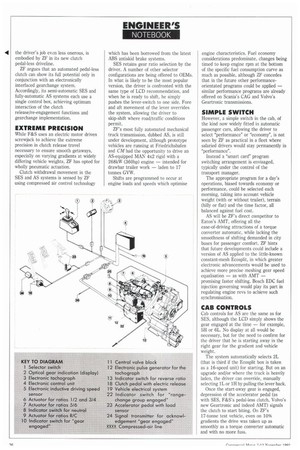ENGINEER'S
Page 38

If you've noticed an error in this article please click here to report it so we can fix it.
NOTEBOOK
the driver's job even less onerous, is embodied by ZF in its new clutch pedal-less driveline.
ZF argues that an automated pedal-less clutch can show its full potential only in conjunction with an electronically interfaced gearchange system. Accordingly, its semi-automatic SES and fully-automatic AS systems each use a single control box, achieving optimum interaction of the clutch release/re-engagement functions and gearchange implementation.
EXTREME PRECISION
While F&S uses an electric motor driven screwjack to achieve the extreme precision in clutch release travel necessary to ensure smooth getaways, especially on varying gradients at widely differing vehicle weights, ZF has opted for wholly pneumatic actuation.
Clutch withdrawal movement in the SES and AS systems is sensed by ZF using compressed air control technology which has been borrowed from the latest ABS antiskid brake systems.
SES retains gear ratio selection by the driver. A number of other selector configurations are being offered to OEMs. In what is likely to be the most popular version, the driver is confronted with the same type of LCD recommendation, and when he is ready to shift, he simply pushes the lever-switch to one side. Fore and aft movement of the lever overrides the system, allowing the driver to skip-shift where road/traffic conditions permit.
ZF's most fully automated mechanical truck transmission, dubbed AS, is still under development, although prototype vehicles are running at Friedrichshafen and CM had the opportunity to drive an AS-equipped MAN 4x2 rigid with a 268kW (360hp) engine — intended for drawbar trailer work — laden to 17 tonnes GVW.
Shifts are programmed to occur at engine loads and speeds which optimise engine characteristics. Fuel economy considerations predominate, changes being timed to keep engine rpm at the bottom of the specific fuel consumption curve as much as possible, although 2F concedes that in the future other performanceorientated programs could be applied — similar performance programs are already offered on Scania's CAG and Volvo's Geartronic transmissions.
SIMPLE SWITCH
However, a simple switch in the cab, of the kind now widely fitted in automatic passenger cars, allowing the driver to select "performance" or "economy", is not seen by ZF as practical in a fleet where salaried drivers would stay permanently in "performance".
Instead a "smart card" program switching arrangement is envisaged, typically under the control of the transport manager.
The appropriate program for a day's operations, biased towards economy or performance, could be selected each morning, taking into account vehicle weight (with or without trailer), terrain (hilly or flat) and the time factor, all balanced against fuel cost.
AS will be ZF's direct competitor to Eaton's AMT, offering all the ease-of-driving attractions of a torque converter automatic, while lacking the smoothness of shifting demanded in city buses for passenger comfort. ZF hints that future developments could include a version of AS applied to the little-known constant-mesh Ecosplit, in which greater electronic advancements would be used to achieve more precise meshing gear speed equalisation — as with AMT — promising faster shifting. Bosch EDC fuel injection governing would play its part in regulating engine revs to achieve such synchronisation.
CAB CONTROLS
Cab controls for AS are the same as for SES, although the LCD simply shows the gear engaged at the time — for example, 5H or 6L. No display at all would be necessary, but for the need to confirm for the driver that he is starting away in the right gear for the gradient and vehicle weight.
The system automatically selects 2L (that is third if the Ecosplit box is taken as a 16-speed unit) for starting. But on an upgrade and/or where the truck is heavily laden, the driver can override, manually selecting 1L or 1H by pulling the lever back.
Once the start-away gear is engaged, depression of the accelerator pedal (as with SES, F&S's pedal-less clutch. Volvo's new Geartronic and indeed AMT) signals the clutch to start biting. On ZF's 17-tonne test vehicle, even on 10% gradients the drive was taken up as smoothly as a torque converter automatic and with no more fuss.




























































































































